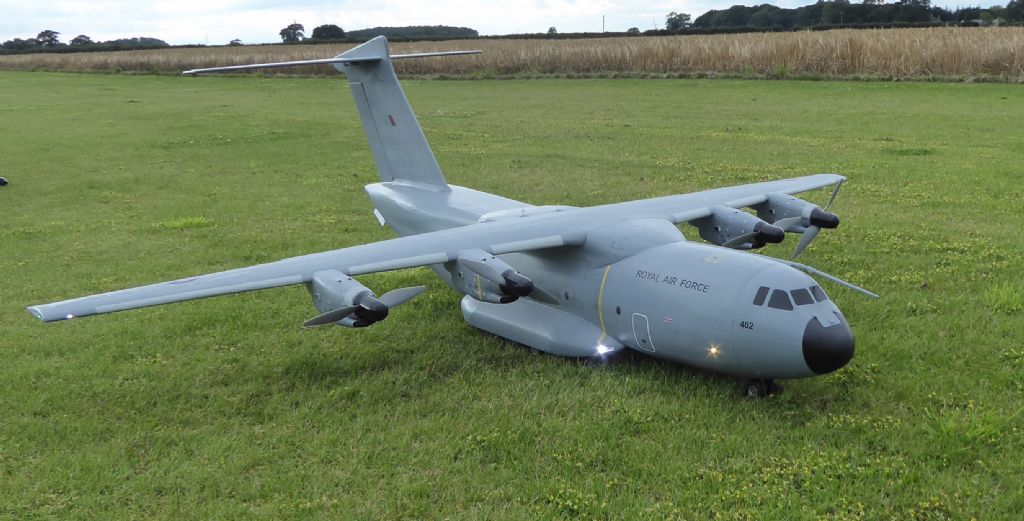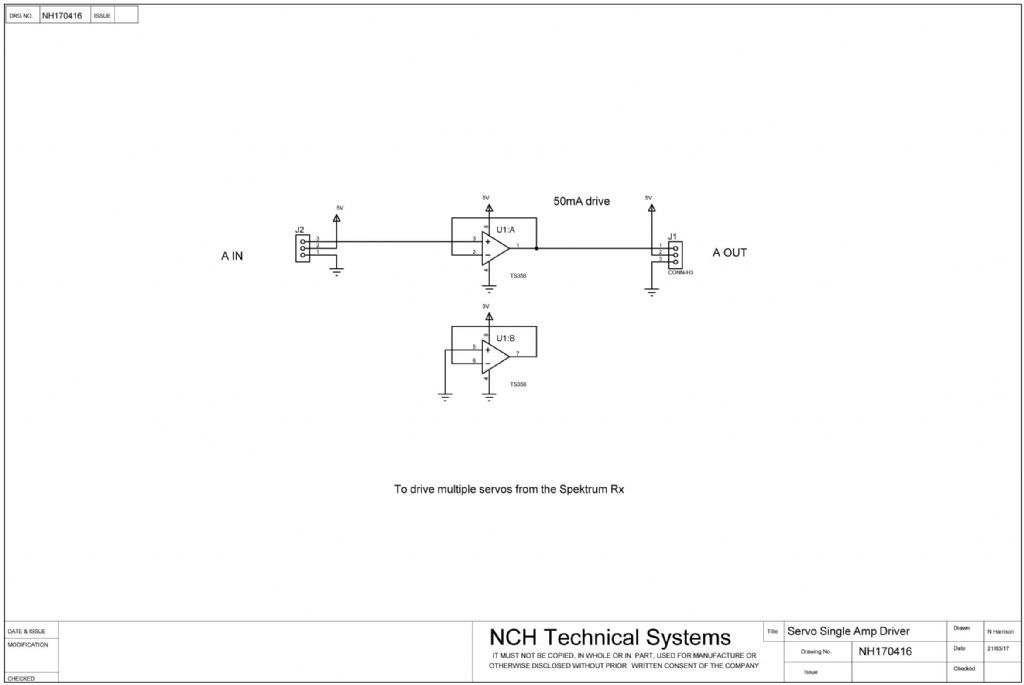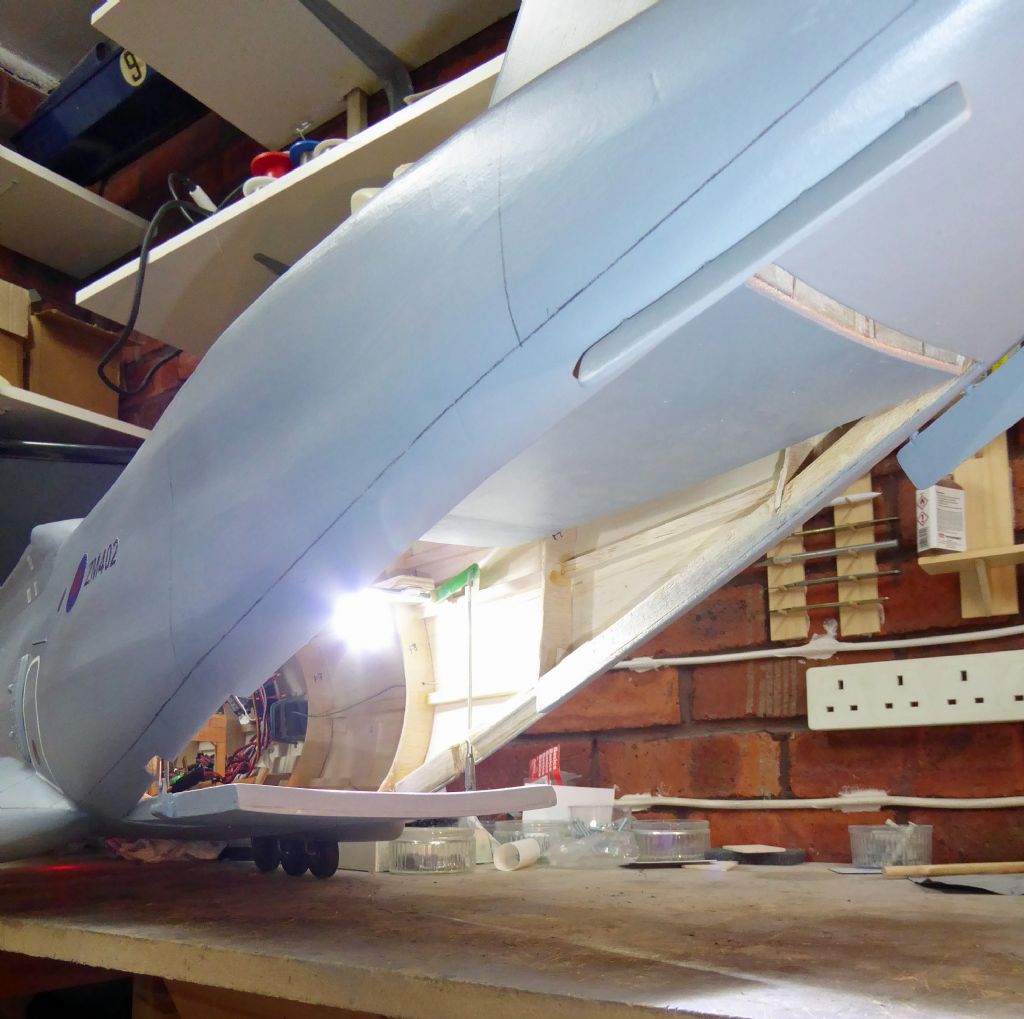-
Posts
329 -
Joined
-
Last visited
-
Days Won
1
Content Type
Profiles
Forums
Blogs
Gallery
Calendar
Downloads
Posts posted by Nik Harrison
-
-
John,
I had problem very like yours with a set up I had using a quad ESC on my A400. It would not work if all four throttle signals were joined up. It would work on any 2 but not four. Lack of current drive was the problem. Solved by building a unity gain amp which then ensured correct drive. Details were discussed in forum
Design & Build FW 200 Condor / Syndicato if you want further details.
Cheers
Nik
-
The point I return to is that the unit initially work correctly. All control surfaces were correctly working with unit on or off. Stabilisation correction worked correctly at first it was only in the air that it changed, or that's when I discovered it had changed. Now the unit does not work the ailerons correctly. I put it down to component failure which is why I'm not interested in using it or even replacing it. Once bitten etc.
Cheers,
Nik
-
Thanks for the replies. I can assure you all that the all surfaces initially responded by moving in the correct direction when the plane was moved. I double and double checked that before flying. As for gain setting I had the gain set so that the surfaces did not appear to move as I moved the model. I intended to slowly increase the gain as confidence grew.
The unit now does not move the ailerons when switched on, except at max throw, then sticks at max throw. Rudder and elevator work fine, unit on or off. Ailerons work only with unit switched off.
Unit was mounted at CoG and fixed with powerlock tape. Powerlock is good enough to hang shelf with so should hold the OrangeRX down.
I'll put this down to experience and stick with the original Rx setup I had.
Thanks again.
-
Has anybody used the the OrangeRX Stabilizer? Full title OrangeRX RX3S 3-Axis Flight Stabilizer V2 (V2.1 firmware) (V-tail/Delta/AUX) from HobbyKing.
I decided to fit one to my A400 Atlas (Nijhuis version) as it is effected by the wind and I had loads of room. It's not expensive (£14) and lots of advice available on Youtube. Got it working on the bench fine so off to the field. The gains were set mid position as I wanted to check out all was well before slowly increasing.
Took off and gained two mistakes high before switching on the OrangeRX. The plane did not react - good - but would not turn with ailerons. Large movement on ailerons caused the plane to roll and head to the deck rapidly. Switched off the OrangeRX and landed successfully if not a bit shaken. On inspection on the ground the ailerons with the OrangeRX switched on are frozen until max stick then stay at max. All well with it switched off.
It has now been removed from my pride and joy and will not be going back in. Has anybody else had any success or problem with this unit?
-
Plan is from Tony Nijhuis. . First appeared in RCM&E in November 2005. Power is via a quad ESC, each channel capable of 30A, using a 3S 6000mAh battery. Motors are as recommended by 4-max (PO-2834-1020) with 9x6 props. Drawing around 750W. First flight was only 2mins and that used 25% power so 5min flights should be OK. Bent the nose wheel leg on landing but that was easy fixed. Next time I'll try the undercart retract and the rear doors opening. Had 4 flights so far and all is well. Flies nice even though the latest ad for the A400 shows a power recommendation of 500W per motor. Sounds a bit overkill.
Youtube URL is https://youtu.be/stn-QRFsRkg
and
https://www.youtube.com/watch?v=znovjxlXM2M

Cheers,
Nik
PS. Paratroopers are in training at the moment.
Edited By Nik Harrison on 05/08/2017 12:12:27
-
Hi Robert,
Glad you got it all sorted. Looking forward to seeing the finished plane.Regards,
Nik -

 Hi Robert,
Hi Robert,
Like your model. Fancied the Condor myself. Anyway the problem you describe is not too dissimilar to the problem I had on my Nijhuis A400.
Using the AR8000 Rx which I had successfully used on my Beverley which used one ESC per motor I decided to use a quad controller on the A400 (cheaper). The Rx was unable to drive the 4 control signals to the quad ESC. It could drive 2, but not 4. Scope monitoring shown that the drive from the Rx was insufficient. It had worked OK in the Beverley without a problem.
Solution was to build a simple transistor driver that would take the load off the Rx. This worked OK and I continued with the commissioning.
Second problem was when the rudder and front wheel steering servos were connected with a Y lead. Rudder servo just went mad. Each servo worked OK if on its own. As I had already build the servo buffer I tried that. It made no difference and servos continued to go mad. Solution was to build a dual unity gain buffer for each servo. This isolated the servos from each other and they now work perfectly OK.
The aileron servos are on a Y lead and no problem has been encountered with them.
The elevator servos have a servo reverser on one servo and no problems with them.
Electric reacts on main and front - no problem.
Two servos driving the rear doors - no problem.I have tried the find if anybody else has had this problem, but no joy. All I can say is my solution works fine and so for one successful flight has been had. I did bend the front leg but I usually do anyway.
Hope this helps. I have attached schematics of the circuits I used. The simple transistor driver showed that the Rx was driving less than 2mA. No idea if this is correct though. If you go down this way use the opamp drivers.
Regards,
-
I have a question on the remote receiver used with the AR8000. I originally used the DX8 in DSM2 mode as originally supplied. I upgraded the DX8 software and was able then to use DSMX. The AR8000 works fine as DSMX. A broken cable to the remote receiver made me source a replacement and then I discovered that there was a DSM2 remote and a DSMX remote [more expensive]. My remote is marked as DSM2. I bought the DSMX remote and all is working fine. Did I need to buy a DSMX remote or would a replacement cable have been enough?
-
Pity us living in the Hull area. We have only one ISP, Kingston Communications, even though others are allowed they cannot be bothered. The speed I get is OK but I pay too much for it. The white phone boxes are a novelty at first but it soon wears off. Cheers
-
Vulcan 607 by Rowland White.A cracking read!!
-
1 Mode 22 Beverley, East Yorks.3 Beverley, East Yorks.4 Self taught.
-
Snap DragonWhy not?
-
I'd would also recommend South Herts Models. Used both their single and twin units with great success. Worth every penny.Nik

-
There is this device which I have tried in my model which uses two 4S batteries.It cuts off the motors off OK at 3v per cell, but I was hoping for a more gradual speed reduction. German translation not the best but I eventually got it to work.
Nik
-
Adrian,I fly a Bf-110 with RCV58CD engines. There is no noticeable swing on take off. I would not recommend the Mossy as your first twin - I had a 0.25 twin and 0.15 twin, both sports models to gain experience before embarking on the Bf-110.I also thought about gyros and engine sync but eventually dismissed them as to much bother. I did make a device that used the spare flap channel to enable me to "lock" one engine at a predetermined speed and the other on Tx control. PM me if you are interested. I did eventually do a circuit on one engine. I also used a simulator to practice one engine flying. The hardest part is recognising an engine has failed quickly enough to do something about it.The problem with engine syncing is that you have to detect the rotation. The only reliable method I found was to mount a magnet in the prop driver then use a sensor to detect the magnet. I decided that was too much bother never mind doing the electronics. The best advice I read was if you are the kind of person that always has to adjust/fiddle with an engine to make it work then a twin was not for you.
I would recommend an on-board glow for added security. Engine reliablity is the name of the game.
Don't let me put you off - twins are fantastic and well worth the effort.
 Nik
Nik
-
Just found your thread - you may be interested in a device a made some years back. I love twin planes but I wanted a safe way to learn to fly single engine. I was using IC engines at the time. I modified the model to have a servo per engine and used the flap channel - unused on model - to control which engine is used. My Tx has a knob for the flap channel. Features :1. Flap control in mid-position then throttle input drives both engine servos.
2. Flap control CCW sets engine1 to pre-set position[A]. Throttle drives only engine2.3. CW reverses the above.
4. Lost throttle signal sets both engines to pre-set position[B]. i.e. low throttle.Position[A] and [B] are programmed using the flap channel whilst on the ground and stored for future use. I used a PIC [8pin] and have flown many flights with it. The only mod I had to do was to glue a small piece of wood on to the flap knob so that I could feel its position instead of looking. I did manage to fly single engined as well.
Should be just the job for steering a float plane on water. Will work with ESC just as well.If interested I could PM the details.
Nik
-
Myron,I'd suggest the only way you can use these devices is by being familiar with and used to making Surface Mount type PCBs. This modern stuff does have legs on the chips but not as we know it!If you are designing a Rx pack with a battery redundancy system then these could be very useful. As per the systems that the LMA people use.
It is not aimed at making a charger system specifically, but there are many occasions that you want to use a diode but do not want the volts drop across it.
Cheers.
-
If you're not sure what a "Schottky" is this thread may not mean much, but it could still be useful. Some new devices have appeared on the market that use a FET to work as an ideal diode.LTC 4358 is a small self-contained device offering 5A with voltage range 9v to 26.5v. LTC 4358
I also found an earlier device that uses an external FET, but offers a voltage range of 2.5V to 28v. Claimed typical voltage drop of 20mV. LTC 4412 Notes
Typical use would be as a dual supply system for Rx etc. Altougth I have seen articles claiming that diode ORing was not required if using NiCd Rx batteries it maybe more important with LiPo batteries.Check them out it's worth a look. There's a family of these devices - some dual packages etc. but these look the most interesting.
Cheers Nik
-
Video sound was fine for me! I was confused at first though - for some reason I thought it was to be a tutorial on how to make videos - as in videoing model aircraft, but no doubt somebody will do one eventually. Well done.
-
Phil,Servo Slow looks good. It's much smaller than mine as I used PCB so that I could fit an 8pin socket on to it. Makes it easier to program if it can be removed from the board. I've not yet mastered the technique of getting the program right first time!!Cheers
-
Weasel,Having done a few IC twins I would suggest that you would have no problems. I gave up on the tacho and found the ear a better instrument. The beat frequency is very distinctive and you soon get used to which motor to adjust. Just keep the motors on the rich side. I set No1 at max throttle, but slightly rich, then adjust No2 to the same max speed. What is more important is that both motors respond the same. The servo movements on each motors must be exactly the same. Check and double check and you should be OK.
Cheers, Nik
-
Just checking my account on the new site and found ( set a status) under my name. What does this mean? Clicking on Ok or Cancel have no effect. Is there something that I should be doing?
-
Slight correction on the dB rating. It's a log scale - but not as Rob stated. A change in power ratio by a factor of 2 [i.e double the noise] is approx. 3dB. Therefore if the noise is 80dB then double is 83dB and double 83dB is 86dB etc.
It does make a difference.

Nik
-
I've used on-board glows with great success with my twin IC machines. Check out the Bf-110C build in the gallery.
The one I used is from South Herts Models [just google] and is designed to only power the plug when it senses that it needs it. I'm able to start OK with it and the tickover is much improved with it fitted.
My reason for using one [I've used one per engine and a twin unit that does two engines] was for easy of starting - no daggling wires when starting a twin - and confidence on the tickover.
Highly recommended.
Nik






Fowler Flaps
in Scale Matters
Posted
Just a thought, but could you not use the internals of some electric retracts to get the screw thread. It would have motor and electronics all available.